Let the stove last a century: how to prepare a mortar from fireclay for masonry
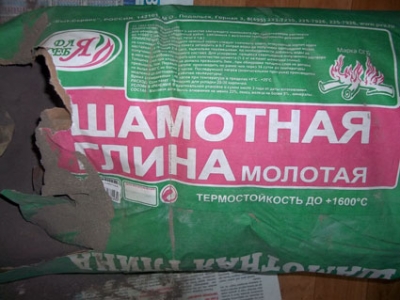
Chamotte clay mortars differ from conventional clay-sand pastes increased heat resistanceThey are used for laying the firebox, since the bricks in this area are exposed to high temperatures.
The dried fireclay mixture has high strengthA firebox laid out using such material does not require repairs for several years, even with constant use.
Content
Composition of fireclay
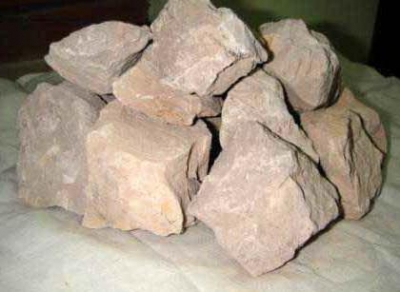
The main component of fireclay mortar is fired kaolin (chamotte). Kaolin is a natural clay, a sedimentary rock. It is very viscous, plastic material.
Kaolin clay consists of kaoliniteThe chemical formula of this mineral is Al4[Si4O10](OH)8. Clay contains impurities:
- oxides of potassium, magnesium, calcium, sodium;
- iron and titanium hydroxides and their sulfides.
Kaolinite is fired at temperature 1300-1850 degrees CelsiusWhen heated, the bound water is removed from the mineral formula and chamotte is obtained. During the enrichment and firing process, sulfides and hydroxides of titanium and iron are removed.
The fired mass partially sinters and loses its plasticity; after heat treatment, the material acquires its the main quality is fire resistance. The pieces of the resulting chamotte are crushed to a finely dispersed state and to crushed stone with fragment size 0.5-2.5 mm. Depending on the firing technology, they receive two types fireclay:
- highly annealed (water absorption - from 2 to 10% water);
- low annealed (water absorption - up to 25% water).
Reference. Common clay contains not only kaolinite but also other clay minerals. The amount of constitutional water reaches 14%. The low (compared to chamotte) heat resistance of ordinary clays is associated with their heterogeneous composition and a large amount of bound water.
Characteristics: Why is this good for laying stoves?
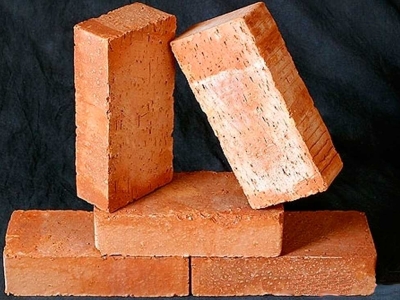
Fireclay clay mortars perfect fit for laying fireclay bricks, since the brick and the binding paste have same coefficient of linear expansion.
When heated, such a masonry expands evenly, no cracks form in the seams.
Fireclay mortar is also suitable for laying ceramic bricks. characteristics fireclay clay, which makes it suitable for the construction of furnaces, include:
- High heat resistance (the fired mortar does not crack when temperature 1300-1850 degrees, depending on the initial characteristics of the fireclay).
- High adhesion (gives off water well ceramic and fireclay bricks and adheres tightly to them).
- Strength in thin seams, that allows do the laying with 3-5 mm thick.
- Strength in wide vertical joints (fireclay you can fill the gaps width up to 12 mm).
Important. The consumption of fireclay mortar for stove masonry depends on the thickness of the seams and is 20 kg for 50-100 bricks.
Where and why is fireclay used?
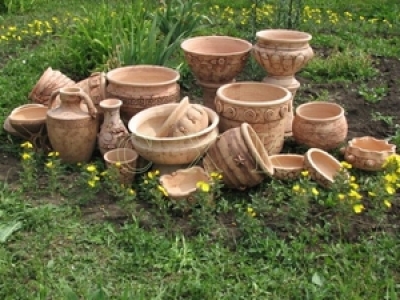
Heat-resistant fireclay is used not only for the construction of household stoves. It is used for masonry metallurgical and other industrial furnacesChamotte is a filler for refractory concrete.
The applied use of chamotte is also widespread. This material is used to make sculptures for the garden, stucco decorations buildings, decorative ceramics, panels and clay souvenirs, pottery.
Vessels made of chamotte are durable and elegant. Potters mold light jugs, vases, and bowls with thin walls from chamotte clay. The fired dishes produce a melodic, pleasant ringing, similar to the ringing of a crystal vessel.
How to choose quality clay
Fireclay called "Kaolin" and ready-made mixtures sold in hardware stores. There are good reviews about both Russian and foreign manufacturers of this heat-resistant material. The best is considered to be fireclay produced at enterprises Western Europe.
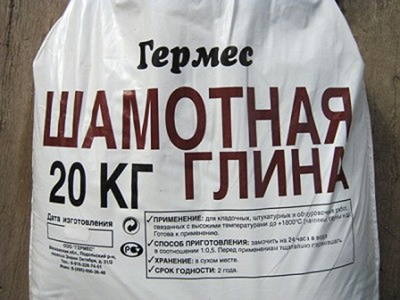
When choosing materials, pay attention to year of production and its qualityA quality mixture and clay do not contain particles exceeding the fraction size indicated on the packaging.
In the mixture for preparing the solution shouldn't be crushed stone or sand larger than 2.5 mm.
Letter "U" on the package indicates that the fireclay is made from recycled, reclaimed material. Letter "Sh" It means that the material has not been recycled and is better suited for laying the firebox.
Construction materials are stored in specially equipped warehouses. If fireclay is stored in in a dry room, in sealed bags, at a temperature from plus 40 to minus 40 degrees, then the shelf life of mixtures and clays is not limited. Long-term storage (more than three years) in conditions of high humidity will lead to deterioration of the material properties due to moisture saturation.
How to Properly Prepare Clay Solution
Fireclay before use soak. The material is filled with water so that it completely covers the clay powder. Ingredients mix thoroughly, so that there are no lumps or dry clay left in the corners of the vessel. Capacity hermetically sealed and leave for three days.
Manufacturing steps: dilute the mixture for construction with your own hands
To prepare you will need: large vessel, cold water, stirrer, mixer, fireclay, fireclay sand (crushed stone) or quartz sandThere are different recipes for fireclay compositions:
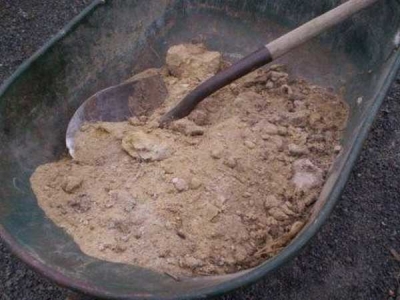
- 1 measure fireclay clay, 2-4 measures fireclay sand, crushed stone;
- 1 measure fireclay clay, 3-5 measures quartz sand.
Quantity water and take it exactly in accordance with the instructions from the fireclay manufacturer. Temperature indoors - from plus 5 degrees and above (up to plus 60 degrees).
- Clay is poured into the container.
- Fillers (sand, crushed stone) are poured on top of the clay.
- Water is poured on top of the dry ingredients.
- The mass is mixed with a spatula or a construction mixer.
- The container is closed to avoid excessive evaporation of water, and leave for three days.
- After the specified time, the paste is thoroughly mixed again and laying begins.
Reference. Ready-made fireclay mixtures are diluted according to the manufacturer's recommendations. Complex compositions, which include chemical additives, fiberglass, heat-resistant adhesives, plasticizers, cement, do not require long soaking. Such solutions ready to work in 20-25 minutes after mixing.
So, to prepare for work "Clay-fireclay heat-resistant masonry mixture" from the manufacturer Terracotta, you will need capacity, mixer, stirrer, clean and cool waterFor a kilogram of powder take 240 ml water, according to the instructions on the package.
- The mixture from the bag is poured into the tank.
- Water is poured into the vessel and the solution is mixed with a spatula and mixer.
- Pasta stand for 20 minutes, mix again and use for laying. If necessary, add a little water to achieve the desired consistency of the solution.
Methods for checking the quality of the obtained substance
The consistency of a well-prepared clay paste resembles sour cream. The plasticity of the finished mixture is checked in one or several ways.
- The solution is taken with a trowel or spatula, tilt it at a 45 degree angle. A normal solution does not flow off the trowel, does not fall off it in lumps, but stays on the work surface tool.
- The solution is applied to the brick even layer (5 mm) and dry. If the composition is "lean" (contains excess sand), then after drying the paste will crumble from the brick with light mechanical action. A fatty solution will be covered with cracks after drying, it contains a lot of clay and little sand. Normal paste hardens into an even layer without cracksIt does not crumble, does not fall off, does not crack.
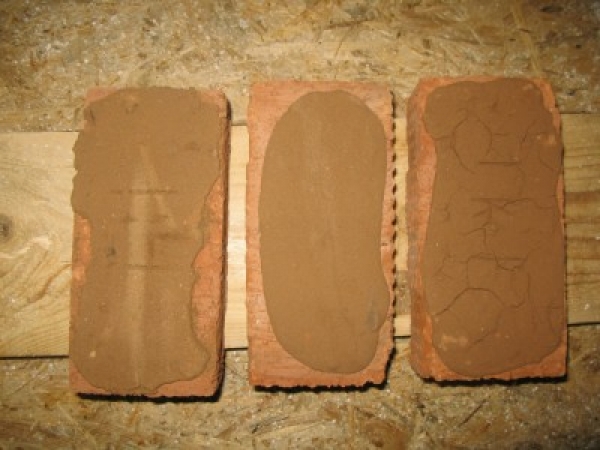
Photo 1. Method for checking the quality of the mortar: on the first brick the dried mixture crumbles, on the third it cracks, the best consistency is on the second.
- Plasticity of the finished mixture check with a flagellum. The solution is rolled out "sausage" with a diameter of 1.5-2 cm and a length of up to 20-22 cm. The flagellum is slow stretch and wrap them a cylindrical object. A tourniquet made of lean clay that is not very flexible will immediately break. A tourniquet made of a fatty mixture will stretch strongly and stick to the surface. A tourniquet made of a solution of normal composition will break when stretched when its diameter is reduced by approximately 20%.
What to do if the solution has dried and has an unsuitable consistency?

If the solution is too thick (the consistency is thicker than sour cream) in it add water and mix thoroughly.
If the solution liquid (flows down from the shoulder blade) into it add all ingredients (clay, sand) in the previously selected proportions and also mix.
Mixture without adhesive additives and cement retains its qualities after drying. It needs to be filled with water and soaked. If the paste has dried completely, soaking will last for several days.
If the solution contains chemical additives included, cement and adhesives, then dried solution cannot be soaked (such as mortar). The manufacturer indicates this information on the packaging.
Useful video
A video showing another way to determine the best consistency of clay mortar and how to mix it.
How long does it take for clay mixture to set
The time it takes for the fireclay paste to dry completely in the air is 72 hours, inside the brickwork this time increases, it depends on the thickness of the masonry, temperature and humidity of the surrounding air. Petrification fireclay mortar occurs at 800 degrees Celsius.
Important! Fireclay masonry does not like sudden temperature changes.
For the first time the stove is heated every three days after the construction is completed. Use thin, quickly burning logs. The dampers and ash pits are fully opened during the first firing. Then the stove dry for a week, burning small amounts of wood every day.
Fireclay masonry dries faster than masonry made of ordinary clay-sand mortar and ceramic bricks, but usually only the firebox is laid out of fireclay. Therefore, the start-up time of a furnace with fireclay masonry will be the same as the use of a furnace built on clay and lime mortar. In summer new oven as much as possible warm up after 10-14 days, in winter - after a month.







Comments
Large inclusions in the sand will not allow you to apply the required thickness of seams. The presence of contaminants will significantly reduce the strength of the masonry in the future. During operation, contaminants (soil particles) will simply burn out. The solution will become porous and begin to deteriorate.
After thorough mixing, add clean water in small portions with constant stirring.